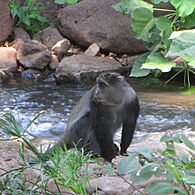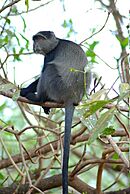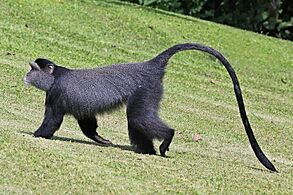Blue monkey facts for kids
Quick facts for kids Blue monkey |
|
|---|---|
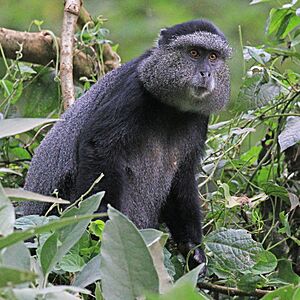 |
|
| C. m. stuhlmanni Kakamega Forest, Kenya |
|
| Conservation status | |
| Scientific classification | |
| Genus: |
Cercopithecus
|
| Species: |
mitis
|
| Subspecies | |
|
6, see text |
|
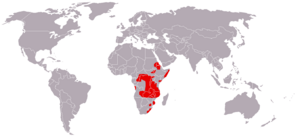 |
|
| Range map (note: includes the range of the closely related Sykes', silver, and golden monkey) | |
The blue monkey or diademed monkey (Cercopithecus mitis) is a type of Old World monkey. These monkeys live in Central and East Africa. You can find them from the upper Congo River basin all the way to the East African Rift. They also live south into northern Angola and Zambia. Sometimes, other monkeys like the Sykes', silver, and golden monkey are considered types of blue monkeys.
Contents
Different Types of Blue Monkeys
There are several different types, or subspecies, of blue monkeys. These are slightly different versions of the same animal. They might have small differences in their looks or where they live. Some examples include:
- Cercopithecus mitis boutourlinii – found in Western Ethiopia
- Cercopithecus mitis kolbi – found in Kenya
- Cercopithecus mitis stuhlmanni – a common type of blue monkey
-
A blue monkey in Lake Manyara National Park, Tanzania
-
Another blue monkey in Lake Manyara National Park, Tanzania
What Blue Monkeys Look Like
Even though they are called "blue monkeys," they are not really bright blue. They have very little hair on their faces. This can sometimes make their faces look a bit blue. But they are not as vividly blue as a mandrill, for example.
Most of their fur is olive or grey. Their face is dark, but they have a light or yellowish patch on their forehead. This patch looks like a crown, which is why they are also called "diademed monkeys." Their cap (top of the head), feet, and front legs are blackish. The fur on their back can be brown, olive, or grey.
Blue monkeys are usually about 50 to 65 cm (20 to 26 inches) long. This measurement does not include their tail. Their tail is almost as long as their body! Female blue monkeys weigh a little over 4 kg (9 pounds). Males are larger, weighing up to 8 kg (18 pounds).
Where Blue Monkeys Live and What They Eat
Habitat
Blue monkeys live in evergreen forests and mountain bamboo forests. They spend most of their time high up in the trees. They do not come down to the ground very often. These monkeys need places that are humid and shady with lots of water. They prefer to live in tall trees. These trees give them both food and a safe place to live.
Sadly, blue monkeys are losing their natural homes. This happens when forests are cut down. Sometimes, if pine trees are planted instead of natural forests, the monkeys might eat the bark from these new trees. They do this to find food or water. People also hunt blue monkeys for food.
Diet
Blue monkeys mainly eat fruit and leaves. They also eat insects that move slowly. Their diet is about half fruit. Leaves or insects are their main source of protein. They also eat seeds, flowers, and fungi. They rarely eat other animals with backbones.
They eat many different kinds of plants. However, they focus on just a few types of plants. This means that how many blue monkeys can live in an area depends on how many different plant species are there. It also depends on how many of those plants are available.
How Blue Monkeys Behave
Blue monkeys sometimes join up with red-tailed monkeys for extra safety. They even groom each other, which means they clean each other's fur.
Social Structure
Blue monkeys live in groups where the females stay in their birth group. This means the females are "female-philopatric". The males, however, leave their birth group once they become adults. So, a blue monkey group usually has one male, several females, and their babies. This creates groups led by the female family lines. Sometimes, you might see a male blue monkey alone. These males are probably traveling, looking for a new group to join.
Social Relationships
In these groups, the monkeys spend only a small amount of time (5-15%) on social activities. The most common social things they do are grooming and playing. How they interact depends on who they are. Babies interact most with other young monkeys and adult or young females. They are rarely seen near adult males.
Blue monkeys often help take care of each other's babies. This is called Alloparenting. Young females are usually the ones who help the most. Often, one baby is carried and cared for by several helpers. One idea is that this helps the baby learn how to be social early in its life.
Female blue monkeys have interesting relationships with each other. These relationships are shaped by what they eat and how they find food. Blue monkey females compete strongly with other groups and other species for food. This is because they are very territorial. However, they have milder, but more frequent, competition within their own group.
Even though it was once thought that blue monkeys were not territorial, newer research shows they are. Also, fights within blue monkey groups are usually mild and do not happen often. This is because females keep some distance from each other. They also feed in different spots to avoid competing for food. While blue monkeys were thought to be equal, new research shows that female blue monkeys have a clear pecking order. This order becomes more obvious when there is not much food.
Reproduction and Life Cycle
Blue monkeys have a mating system where one male mates with several females. This is called "polygynous." Because of this, males are much larger than females. Females usually give birth every two years. This happens when the warm, rainy season begins. Pregnancy lasts about five months. Babies are born with fur and their eyes open.
A group of blue monkeys can have 10 to 40 members. There is usually only one adult male in the group. Blue monkeys are often found in groups with other monkey species. These can include red-tailed monkeys and different kinds of red colobus monkeys.
Male blue monkeys mate with more than one female. However, females usually only mate with one male. Females use their body language to attract males. They can breed throughout the year. Groups can have up to 40 members. The females in the group usually help care for all the young, not just their own babies.



